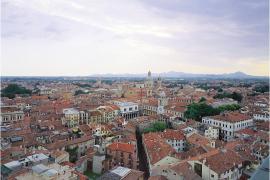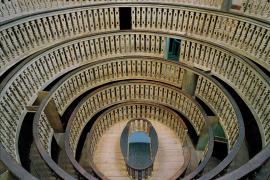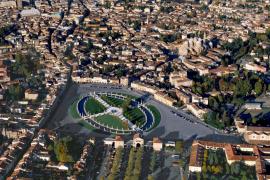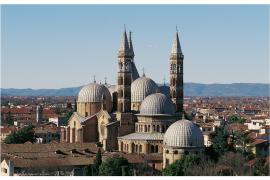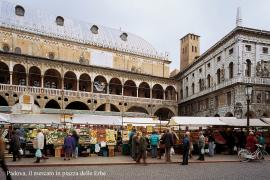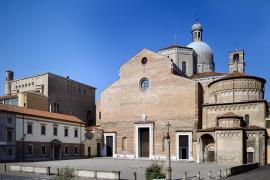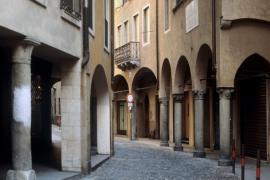A day in Padova
A guided tour to discover the city of Padova: here is an itinerary planned for those who wish to visit not only areas of artistic and cultural interest but also to discover the heart of Paduan life. And even Paduan residents may like to know more about the interesting parts of their city.
For visitors arriving by train, the station is not far from the centre, which can easily be reached on foot.
For those arriving by car: we recommend you leave your car in the Via Trieste car-park, a few steps from the Scrovegni Chapel, or in the station car-park, where our tour begins.
- Scrovegni Chapel
- Caffè Pedrocchi
- University of Padova
- Prato della Valle
- Sant'Antonio (Basilica of St Anthony)
- Tomb of Antenor
- Padova's Squares and the Salone
- Piazza dei Signori
- Duomo e Battistero (Cathedral and Baptistry)
- The Ghetto
Scrovegni Chapel
Leaving the station forecourt, take Corso del Popolo, the road immediately in front of you: after the bridge, on the left, you will find the Arena Gardens and, a few steps beyond, the Eremitani City Museums.
Tickets for the Museums also include entry to the Scrovegni Chapel, absolutely not to be missed. The Chapel contains the cycle of frescoes painted in 1303-04 by Giotto, a stupendous work which had revolutionary effects on the history of European art, perhaps because this master artist tried, from the viewpoints of expression and perspective, to reflect real life.
Bookings for the Chapel are compulsory, and should be made at least 48 hours in advance. Contact the call center (+39 049 2010020) or go on-line. Tickets must be collected one hour before the time marked on your ticket - but don't worry: in the meantime, you can:
- visit the Museum, which includes sections on archaeological and the visual arts, with works by Giotto, Veronese, Tintoretto, Giorgione and Titian;
- walk round the Arena Gardens, which still contain a small section of the original Roman arena, used as an open-air cinema in the summer;
-visit the 12th-century Eremitani church next to the Museum. This church was destroyed by bombing on March 11 1944 and has been almost totally reconstructed: only two of Mantegna's exquisite frescoes could be saved.
return to index
Caffè Pedrocchi
Return to Corso del Popolo, and walk on a short distance to Piazza Garibaldi, where the Listòn (pedestrian area) begins: one of the most crowded areas of the city on Saturday afternoons.
Walk straight on along Via Cavour and, on your right, you will very shortly come to the stone lions guarding the Caffè Pedrocchi, built in the early 19th century. It became famous as the lively and popular "coffee-house without doors", since it used to be open 24 hours a day. It was here on February 8 1848 that the students' insurrection against the Austrians was sparked off. Take a little time to:
- drink a cup of coffee in the famous Sala Rossa (the Red Room)
- take a little trip in time and space in the first-floor rooms, in various styles (Etruscan, Greek, Roman). Access is from Piazzetta Pedrocchi, but the Caffè is only open as follows: 9:30-12:30 and 15:30-18:00 (closed on Mondays)
- visit the Museum of the Risorgimento and of the Contemporary Age
Caffè Pedrocchi periodically organises concerts, mainly jazz, and also literary meetings, poetry readings, etc.
For information, contact the nearby Ufficio Informazioni Turistiche (tourist office), just behind the Caffè Pedrocchi :
Galleria Pedrocchi
Tel. +39 049 8767927
Open: 09:00-13:30/15:00-19:00
Closed: Sundays
return to index
University of Padova
Slightly further on, opposite the Municipio (Town Hall) is the main building of the University of Padova. This is the Palazzo del Bo': its name derives from the old Albergo del Bue (Hostel of the Ox), which was originally the seat of the law school in the 16th century - the University was founded in 1222, one of the first in Europe.
Admire the fine 14th-century courtyard: when students' theses are debated (February-March, June-July, September-October) here and more or less everywhere in the centre of the city there are noisy and festive celebrations by students who have just been awarded their degrees. Their friends dress them up in all kinds of clothing (or lack of it), throw them in the fountain of the nearby Piazza delle Erbe, ask them to read aloud very rude poems prepared for the occasion, and generally have a good time ... after all, you're only young once!
To admire other "historical" places of Palazzo Bo - of particular interest are the Anatomical Theatre and Galileo's chair - there are also guided tours.
For information:
Ufficio Informazioni Turistiche
Galleria Pedrocchi
Tel. +39 049 8767927
Open: 09:00 - 13:30/15:00-19:00
Closed: Sundays
return to index
Prato della Valle
From Palazzo del Bo, take Via Roma and walk straight on into Via Umberto I. At the end of this road, you will come out into the untranslatable Prato della Valle, "the greatest square in Europe" (88,620 sq.m.). The present-day square goes back to 1775, when the Venetian architect and procurator Andrea Memmo reclaimed the originally marshy land of this vast area, created an oval island in the middle, called the Isola Memmia, surrounded by a canal, and decorated it with a double ring of 78 (originally 87) statues of notable personages of antiquity. He also added four bridges across to the island, some with obelisks, and new space for fairs and shows of all kinds. Today, Prato della Valle is an enormous green space, where tourists and residents alike can rest and admire the surrounding buildings on sunny days.
The area around the island has become popular with roller-skaters, and the island in the centre is always the right place for a short rest in these beautiful surroundings. You can also:
- visit the Chiesa dei Servi (in Via Roma) and its fine 16th-century portico, and the small Chiesa di San Daniele (Via Umberto I), both along the way to Prato della Valle
- stop for lunch: there are many small restaurants and cafés along Via Roma and Via Umberto
- visit the Minici Zotti Collection called "A Museum of Magic Visions", devoted to the art of the magic lantern and popular entertainments in the days of pre-cinema. It is located in Palazzo Angeli, on the corner of Via Umberto and Prato della Valle. For information: + 39 049 8763838, open: 10:00-16:00, closed on Tuesdays.
- visit the Basilica of St Justine (Santa Giustina) (open 08:00-10:00/15:00-18:00), the largest church in the city (and the 11th largest in the world), with its characteristic bell-tower, eight domes and unfinished faͧade. From its origin in the 5th century until its reconstruction after the earthquake of 1117, and subsequent demolition to make space for the colossal 16th-century building of today, this Benedictine basilica has changed its aspect several times. Its naves, with enormous pillars, offer coolness on sultry summer days. Admire the altar-piece by Veronese (The Martyrdom of St Justine, 1575). To see the Old Choir and the architrave of the Romanesque portal, ask at the porter's lodge of the monastery (+39 049 8751628), giving access to the cloisters.
An important point: to admire Prato della Valle in all its splendour, it's best to avoid the Saturday market, which occupies the entire square with stalls selling everything under the sun. It is extremely popular and therefore very crowded (watch out for pickpockets!), but it's good fun. If you want "old things", visit the Prato on the third Sunday of every month, when there is an antiques fair.
return to index
Sant'Antonio (Basilica of St Anthony)
From Prato della Valle, take Via Belludi to reach the Basilica of St Anthony.
In front of the Basilica, among the stalls selling candles, sacred images and souvenirs, is the splendid monument to Gattamelata. In 1447, the Serene Republic of Venice celebrated the services rendered in war of this condottiere (whose real name was Erasmo da Narni) and commissioned Donatello to create an equestrian monument in bronze.
The Basilica of St Anthony is the most important religious centre of the city, and is visited by thousands of pilgrims every year. In particular, on June 13, St Anthony's Day, Padova is invaded by the faithful, and statues, pictures and relics of the saint are carried in procession. The exterior of the Basilica has a Romanesque-Lombard faͧade in brick, and eight domes in Byzantine style. The interior contains very many masterpieces of art, including the bronzes of the main altar and the stone Deposition from the Cross by Donatello, reliquiaries (one of which contains the tongue of the saint) and the chapel of the Blessed Luca Belludi, with frescoes by Giusto de' Menabuoi.
You can now:
- rest in one of the three magnificent cloisters of the Basilica
- admire the early 16th-century frescoes in the Scuola del Santo (open: 09:30-12:30/14:30-17:00, in summer until 19:00; info +39 049 8755235), to the right of the Basilica. Several paintings are by Titian.
- walk among the rare plants in the delightfully peaceful Orto Botanico, the oldest Botanical Garden in the world (Via Orto Botanico 15, open: 09:00-13:00, in summer also 15:00-18:00; info +39 049 8272119).
return to index
Tomb of Antenor
Take Via del Santo and walk as far as the junction with Via San Francesco. Turn left at this point.
In front of the Prefecture, on the left, is the Tomb of Antenor, an urn which, since 1283, has contained the mortal remains of a warrior (2nd-4th centuries AD), which were later attributed to the legendary Trojan founder of the city and the father of the palaeo-Veneto peoples. From this point, you can:
- find many shops and boutiques selling clothes, sacred and other souvenirs, and typical sweets and cakes along the whole Via del Santo. In particular, why not try the Dolce del Santo or Dolce Santantonio, which the Veneto Region has included in its list of traditional agro-alimentary products?
- Palazzo Zabarella, in Via San Francesco at the junction with Via del Santo, hosts many interesting temporary exhibitions (+39 049 8756063)
return to index
Padova's Squares and the Salone
Continuing along Via San Francesco, you will reach Padova's famous squares.
Between Piazza delle Erbe and Piazza della Frutta is the vast bulk of the Palazzo della Ragione, which the Paduans call "Il Salone" - the Great Hall, with its enormous vaulted hall on the first floor. This was used as a court of law until 1797, when the Republic of Venice lost power. The original building goes back to 1218, was repaired after the fire of 1420, and was then damaged by a storm (a "tornado") in 1756, but it has always maintained its original, extraordinary structure. This building is so huge, that perhaps it's better to describe it in two parts.
The ground floor has been home to Padova's covered market for almost 800 years. The types of wares have changed over the centuries: in the times of the Comuni, mainly preciously woven cloth and furs were sold. Nearby shops now sell luxury leather and silk goods, haberdashery, and jewellery and silverware. Originally wine and grain, fruit and vegetables, meat and fish were the main goods sold in Piazza delle Erbe, but now all types of food are sold.
Piazza della Frutta mainly has stalls selling clothing, sometimes ethnic goods, and two large stalls with dried fruit, spices, nuts, cereals and natural products. Some stall-holders roast chestnuts over braziers on cold winter evenings.
A triumphant mingling of scents and colours, the stalls are open every morning (all day on Saturdays). They are brought into the squares every day and occupy specially assigned places in rotation, so that no stall-keeper is favoured more than the others.
The upper part of the Salone owes its name to the enormous hall on the first floor (entrance from the Town Hall courtyard in Via VIII Febbraio). This prodigious space, which now often hosts temporary exhibitions, has all its walls decorated with one of the largest astrological cycles in existence, frescoed in three tiers, with the months, zodiacal signs, and mythological gods or famous personages which represented the seasons of the year and the trades which were common in ancient times. This grandiose calendar was restored after 1420, when the previous series of frescoes by Giotto, including the ceiling painted with stars and planets, was destroyed by the fire of that year. Dominating the Salone is the enormous wooden statue of a horse, the original model for the one by Donatello outside the Basilica of St. Anthony.
For info: +39 049 8205006
From late afternoon onwards, this whole area of the squares becomes crowded with people drinking spritz, the best-loved apéritif of north-east Italy, which is sold in all the bars and cafés in the squares and the neighbouring Ghetto. Originally a mixture of white wine and selz (aerated water), the recipe is now the barman's creation, as is the addition of variable amounts of alcohol.
return to index
Piazza dei Signori
Just beyond the above two squares, with their civic buildings representing the power of the city, is Piazza dei Signori, where the 14th-century da Carrara seigneurs once had their palace. The impressive Piazza dei Signori now contains the Loggia del Consiglio (also called the Gran Guardia), the 16th-century building where the town authorities used to meet, the church of St Clement and, opposite, the imposing Torre dell'Orologio. This splendid clock-tower is part of the triumphal arch of the 16th-century Palazzo del Capitanio, where the Venetian government had its quarters. The actual clock is older, and is a copy of the one installed by Giovanni Dondi in 1344, the first mechanism of this type ever constructed in Italy.
Here, we advise you as follows:
- walk through the arch to Piazza Capitaniato, where the Faculty of Letters and Philosophy of the University occupies the Palazzo Liviano.
- the 17th-century staircase, on the left in the corner of the square, leads to the Sala dei Giganti, a magnificent hall frescoed with more-than-lifesize figures of antiquity. The hall is used for classic and modern music concerts and other cultural events.
- walk through the short road opposite, to reach the delightful Piazzetta di San Nicolò. This church, a gem of medieval aspect (later restored several times) with its tiny square is extremely popular for weddings.
- ... and then, why not have an icecream or a coffee in Piazza dei Signori?
return to index
Duomo e Battistero (Cathedral and Baptistry)
Piazza dei Signori is only a few steps away from the beautiful Piazza Duomo, with its Baptistry.
The Duomo rises on the site of preceding cathedrals, the first of which may have been palaeo-Christian, dating back to the year 300 AD. Rebuilt several times, it was consacrated in 1075 with the translation of the body of St Daniel. The present-day cathedral, partially designed by Michelangelo, was completed in the 16th and 17th centuries, to a project by Andrea da Valle. In 1754, it was consacrated to Santa Maria Assunta (St Mary of the Assumption). The new Presbytery, inaugurated in 1997, is embellished with statues by the Tuscan artist Giuliano Vangi. To the right of the Cathedral is the Baptistry, consacrated to San Giovanni Battista (St John the Baptist).
The Baptistry goes back to the late 12th century. It is square in plan, with a high circular drum and dome, and a small apse with a cupola. The interior was entirely frescoed by Giusto de' Menabuoi between the years 1375 and 1378 with stories from Genesis, the Apocalypse, and the life of St John the Baptist. The whole cycle of frescoes, nearly one hundred in all, is still one of the most beautiful and admired pictorial series of the 14th century.
Open: every day, 10:00-18:00. Bookings are required for groups. Info: +39 049 656914
After these visits, there are still other possibilities:
- admire the works of art in the Diocesan Museum, which contains many treasures of sacred art, including illuminated manuscripts, ancient reliquiaries, paintings by famous artists, including Giusto de' Menabuoi, Jacopo da Montagnana, Giambattista and Giandomenico Tiepolo, and sacred vestments and votive offerings (+39 049 8761924)
- walk through the Arco Valaresso, built in the 17th century in memory of Alvise Valaresso, Venetian sea captain and health officer in the period when Padova was afflicted by outbreaks of plague
- visit one of the exhibitions of paintings or photographs periodically on display in the Palazzo Monte di Pietà , on the corner of Piazza Duomo and Via Manin.
return to index
The Ghetto
South of Piazza delle Erbe is the area of Padova called the Ghetto, inhabited since 1603 and suppressed in 1797. It used to have four gates which were locked at night: the northern gate was in Via delle Piazze, near the church of San Canziano; to the east in Via San Martino e Solferino, near its junction with Via Roma; west in the same street, before the junction with Via dei Fabbri; and south in Via dell'Arco, at the junction with Via Marsala.
The first large synagogue in Padova, inaugurated in 1683 in Via delle Piazze, used the German rite. It was connected to the south with the synagogue practising the Spanish rite; opposite, was the one practising the Italian rite, the only synagogue still open. It was transformed in 1892 to welcome the faithful who used both Italian and Spanish rites. In 1943 it was burnt to the ground " an act of arson. Its restoration was completed in 1998. In spite of these transformations and restorations, the Ghetto still maintains its character, with similar, tall buildings, many enriched with decorations retrieved from other buildings, like the four columns, all with different capitals, in Via San Martino e Solferino, opposite the junction with Via dell'Arco.
Today, this quarter of town has many typical wine shops, bars and cafés. Perhaps the best time to see it is in the late afternoon, when the roads fill with people drinking the local apéritif and chatting.
There is something for everybody here: the places where the students hang out, noisy but welcoming; small, dark, romantic wine bars; others up to the minute ... walk round the Ghetto and choose whichever you prefer! A word of warning: on Sundays it is very difficult to find anywhere open.
For a selection of bars, restaurants, night clubs, and other venues in Padova, go on-line to 2night.it and Gustare Padova. If you like ethnic and non-Italian cooking, try the site http://www.padovando.it.


